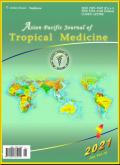马来西亚埃及伊蚊和白纹伊蚊杀虫剂耐药性现状(2010-2022)
IF 1.6
4区 医学
Q3 PUBLIC, ENVIRONMENTAL & OCCUPATIONAL HEALTH
引用次数: 0
摘要
本综述旨在确定2010年至2022年马来西亚野外采集的埃及伊蚊和白纹伊蚊对氨基甲酸酯、有机氯、有机磷和拟除虫菊酯类杀虫剂的耐药性状况。概述了生物和环境控制,重点介绍了马来西亚的蚊媒控制策略。本综述中的信息是在2022年1月至2022年12月期间从PubMed(MEDLINE)、Science Direct和Scopus等多个数据库中提取的,使用的关键词包括“杀虫剂抗性”、“氨基甲酸酯抗性”、”有机氯抗性“、”有机磷抗性“、“拟除虫菊酯类抗性”“伊蚊”和“马来西亚”。利用QGIS软件绘制了马来西亚抗埃及伊蚊和白纹伊蚊的分布图。埃及伊蚊和白纹伊蚊对杀虫剂的耐药性在马来西亚很普遍,尽管各州的耐药性不同。最值得注意的是,在过去十年中,马来西亚雪兰莪州的埃及伊蚊对氯氰菊酯的抗性急剧增加。白纹伊蚊对氯氰菊酯也表现出中度耐药性,尽管不像雪兰莪州的埃及伊蚊那样普遍,但在东马来西亚的砂拉越州表现出耐药性。马来西亚已广泛记录了对四类主要杀虫剂的耐药性。作为马来西亚目前使用的杀虫剂之一,马来西亚对氯氰菊酯的广泛耐药性表明,支持广泛使用氯氰菊酯雾化的政策需要进一步评估。本文章由计算机程序翻译,如有差异,请以英文原文为准。
Insecticide resistance status of Aedes aegypti and Aedes albopictus in Malaysia (2010 to 2022): A review
This review aimed to determine the prevalence of the insecticide resistance status of the field-collected Aedes aegypti and Aedes albopictus in Malaysia from 2010 to 2022 towards carbamates, organochlorines, organophosphates and pyrethroids. Biological and environmental controls were summarized with an emphasis on the mosquito vector control strategies in Malaysia. The information in this review was extracted from several databases such as PubMed (MEDLINE), Science Direct and Scopus by using keywords including “insecticide resistance”, “carbamate resistance”, “organochlorine resistance”, “organophosphate resistance”, “pyrethroid resistance”, “Aedes” and “Malaysia”, between January 2022 and December 2022. Distribution of resistant Aedes aegypti and Aedes albopictus in Malaysia was mapped using QGIS software. Insecticide resistance in both Aedes aegypti and Aedes albopictus is widespread in Malaysia, although the rates vary by states. The most notable was the steep increase in permethrin resistance of Aedes aegypti in Selangor, Malaysia, over the past decade. Aedes albopictus also displayed moderate resistance to permethrin, though not as widespread as Aedes aegypti in Selangor, but showed sign of resistance in Sarawak, East Malaysia. Resistance towards four main classes of insecticides have been widely documented in Malaysia. The extensive resistance towards permethrin in Malaysia which is one of the current insecticides used in Malaysia suggested that policies supporting the widespread use of permethrin fogging needs further evaluation.
求助全文
通过发布文献求助,成功后即可免费获取论文全文。
去求助
来源期刊

Asian Pacific journal of tropical medicine
PUBLIC, ENVIRONMENTAL & OCCUPATIONAL HEALTH-TROPICAL MEDICINE
CiteScore
4.00
自引率
9.70%
发文量
1936
审稿时长
3-8 weeks
期刊介绍:
Asian Pacific Journal of Tropical Medicine (ISSN 1995-7645 CODEN: APJTB6), a publication of Editorial office of Hainan Medical University,is a peer-reviewed print + online Monthly journal. The journal''s full text is available online at http://www.apjtm.org/. The journal allows free access (Open Access) to its contents and permits authors to self-archive final accepted version of the articles on any OAI-compliant institutional / subject-based repository.
APJTM aims to provide an academic communicating platform for international physicians, medical scientists, allied health scientists and public health workers, especially those of the Asia-Pacific region and worldwide on tropical medicine, infectious diseases and public health, and to meet the growing challenges of understanding, preventing and controlling the dramatic global emergence and re-emergence of infectious diseases in the Asia-Pacific.
The journal is proud to have an international and diverse editorial board that will assist and facilitate the publication of articles that reflect a global view on tropical medicine, infectious diseases and public health, as well as emphasizing our focus on supporting the needs of public health practitioners. The APJTM will allow us to seek opportunities to work with others who share our aim, and to enhance our work through partnership, and to uphold the standards of our profession and contribute to its advancement.
 求助内容:
求助内容: 应助结果提醒方式:
应助结果提醒方式:


